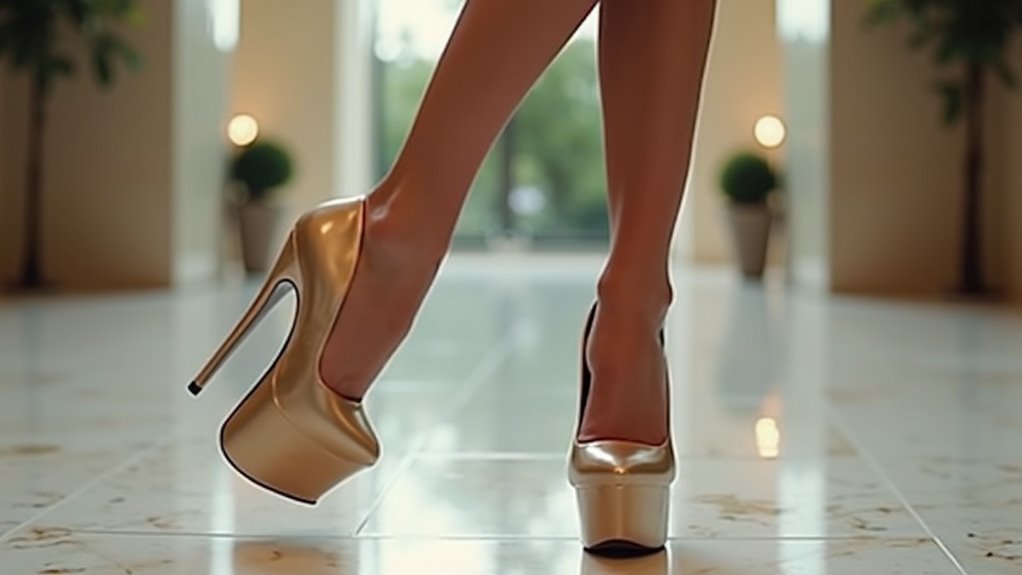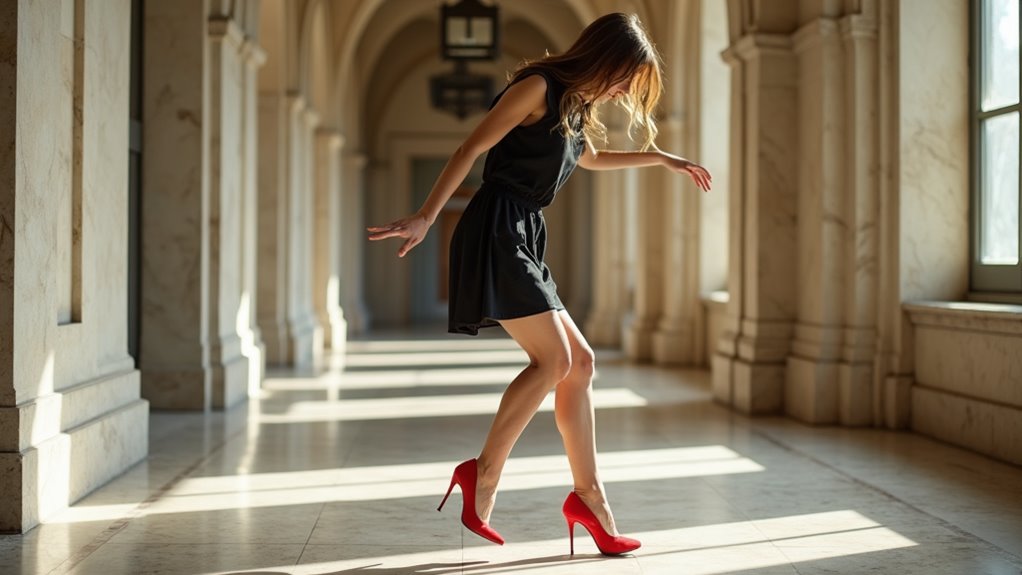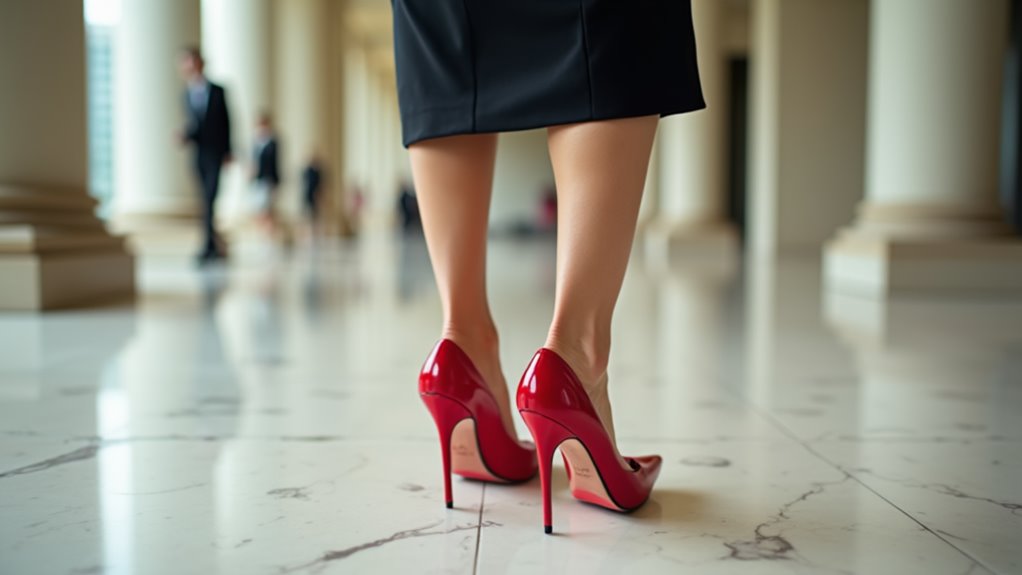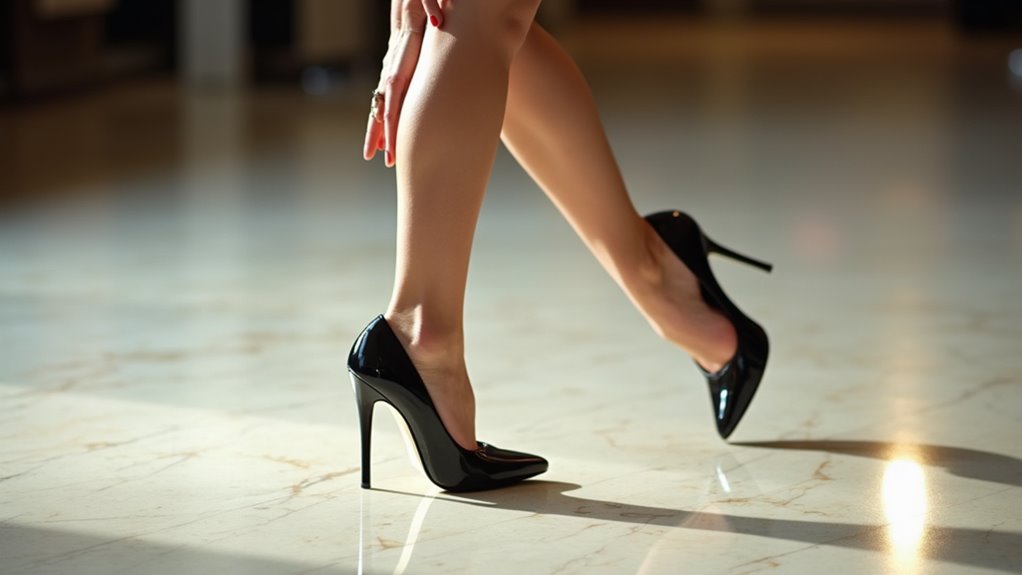There may be products. Products are independently selected by our editors. We may earn an affiliate commission from the links with no charge to you, example: as Amazon Affiliate.
When we’re learning to walk in heels, we often rush into dramatic heights before mastering the basics, leading to several critical mistakes. We’ll stumble by neglecting proper posture, misaligning our weight distribution, and taking overly wide strides. Many of us skip essential ankle-strengthening exercises and ignore the importance of gradual progression through different heel heights. Poor foot placement and exaggerated movements further compound these errors, creating an unstable and awkward appearance. Starting with modest 2-3 inch heels, maintaining proper alignment, and dedicating time to structured practice will elevate your confidence and sophistication. Let’s explore how to transform these common missteps into polished expertise.
Key Takeaways
- Leaning too far forward instead of maintaining proper posture with shoulders back and spine elongated creates instability and poor form.
- Starting with heels that are too high rather than gradually progressing from lower heights undermines confidence and walking mechanics.
- Taking excessively wide strides instead of shorter, controlled steps disrupts balance and creates an awkward, unsteady gait.
- Distributing weight incorrectly by placing pressure on heels rather than the balls of feet causes instability and discomfort.
- Rushing through practice sessions without proper form leads to poor muscle memory and ingrained bad walking habits.
Choosing Excessive Platform Heights

When stepping into the world of high heels, many fashionistas make the critical mistake of choosing excessively high platform heights. We’ve noticed that this eager approach often leads to uncomfortable experiences and potential foot problems, as these extreme elevations disrupt the foot’s natural arch alignment.
Let’s be clear: while platform heights might seem like an easy shortcut to achieving that coveted statuesque look, they’re actually working against you when learning to walk in heels. The elevated design forces unnatural walking mechanics, causing you to lean forward and compromising your stability. This not only increases your risk of taking an embarrassing tumble but also creates poor walking habits that can be difficult to break.
We recommend starting with modest heel heights and gradually working your way up. This approach allows you to develop proper walking techniques while maintaining natural foot alignment. When you wear heels without excessive platforms, you’ll discover that your posture improves naturally, and you’ll build genuine confidence in your stride. Remember, mastering the art of walking in heels is about grace and control, not immediate height gains.
Neglecting Natural Walking Alignment
Three fundamental aspects of walking in heels revolve around proper alignment, yet we’ve noticed many first-time heel wearers completely disregard these natural mechanics. To walk elegantly in heels, we must focus on maintaining a straight-line trajectory, much like a tightrope walker. It’s essential to resist the urge to take lengthy strides; instead, make sure your steps are measured and controlled.
We often observe newcomers making exaggerated movements that compromise their stability. The key is to move with fluid grace, allowing your arms to swing just a little bit at your sides for balanced proportions. This natural arm placement works in harmony with your body’s alignment, creating a sophisticated silhouette as you navigate in your heels. For those concerned about sustainability, eco-friendly non-leather heels offer the same elegant walking experience while being mindful of environmental impact.
Rushing Through Practice Sessions

A common mistake among aspiring heel-wearers lies in their rushed approach to mastering this sophisticated skill. When we’re eager to perfect our stride in heels, we often make the critical error of cramming practice into marathon sessions, which can cement poor habits rather than build confidence. For those seeking to elevate their look, exotic leather look heels offer stunning style options while you master proper walking techniques.
Let’s explore a systematic approach to wearing heels that prioritizes quality practice over rushed results:
| Practice Duration | Environment | Focus Areas |
|---|---|---|
| 15-20 minutes | Home | Basic posture |
| 20-30 minutes | Indoor spaces | Balance control |
| 25-35 minutes | Quiet outdoors | Stride length |
| 30-45 minutes | Various terrains | Advanced techniques |
One of our essential tips and tricks for mastering heels involves breaking practice into shorter, focused sessions throughout the week. We’ve found that this approach allows for better muscle memory development and natural progression. By starting with lower heights and gradually working our way up, we’re able to build a solid foundation. Remember, the key to elegance in heels isn’t about rushing to the finish line—it’s about developing sustainable techniques in familiar environments where we can concentrate on perfecting our form.
Overexaggerated Body Movements
Moving beyond practice sessions, let’s address one of the most common missteps we see in heel-wearing: overexaggerated body movements. When we’re learning to walk in heels, there’s often a tendency to overcompensate with dramatic gestures and exaggerated strides, which can seriously compromise our balance and posture.
The key to mastering heel-walking lies in maintaining a straight line while keeping movements fluid and controlled. We’ve found that excessive arm swinging or taking unnecessarily wide steps only leads to instability and potential mishaps. Instead, we should focus on keeping our movements minimal and precise, with our feet falling closer together as we walk.
One of the most effective ways we can correct these overexaggerated movements is by practicing in front of a mirror. This allows us to observe and adjust our gait in real-time, ensuring our movements remain natural and graceful. Remember, the goal isn’t to create a dramatic runway walk – it’s to achieve an effortless, sophisticated stride that works with our body’s natural mechanics, enhancing both our comfort and confidence in heels.
Poor Posture Habits

Let’s examine how poor posture habits can sabotage our efforts to walk gracefully in heels, particularly when we carry our shoulders forward and drop our heads, creating significant balance issues. We’re often guilty of these postural mistakes, which not only diminish our overall presence but also force our bodies into misaligned positions that make heel-walking unnecessarily challenging. By addressing these slouching tendencies head-on, we’ll transform our heel-walking technique from awkward to elegant, as proper shoulder placement and chin positioning create the foundation for confident strides. Selecting comfort-focused heels can significantly improve your posture by providing better support and stability while walking.
Shoulders Forward While Walking
Confidence crumbles when shoulders slouch forward in high heels. We’ve all seen it – that telltale posture that screams discomfort and uncertainty. Let’s transform this common mistake into an opportunity for elegance and poise.
When we roll our shoulders back, we’re not just improving our appearance; we’re creating a stable foundation for every step. Think of balancing delicate teacups on your shoulders – this visualization keeps you mindful of alignment while preventing the dreaded forward hunch that can lead to falls and strain.
| Posture Element | Common Mistake | Correct Form |
|---|---|---|
| Shoulders | Hunched Forward | Rolled Back |
| Chin | Tucked Down | Lifted Up |
| Upper Back | Rounded | Straight |
Head Down Reduces Balance
Looking down while walking in heels sets off a chain reaction of postural problems that can throw off your entire stride. When we bow our heads forward, we’re disrupting our body’s natural alignment and compromising our center of gravity, making it significantly harder to maintain stability in those stilettos.
Let’s visualize balancing delicate teacups on our shoulders – this elegant imagery helps us maintain proper posture and head alignment. We’ve found this technique particularly effective in developing the muscle memory needed for a confident, steady walk. Remember, your chin position is intrinsically linked to your overall balance and poise.
Here are the key reasons to keep your head aligned while walking in heels:
- Maintaining a chin-up position enhances your natural balance mechanisms and spatial awareness
- Proper head alignment prevents unnecessary strain on your neck and back muscles
- An upright head position projects confidence and naturally improves your walking elegance
Slouching Creates Alignment Issues
Straightening up while wearing heels isn’t just about looking polished – it’s essential for your body’s structural integrity. When we slouch in heels, we’re disrupting the natural alignment of our spine, creating a chain reaction of discomfort that can lead to long-term complications. We’re seeing this mistake all too often, and it’s time to address it head-on.
Let’s focus on what proper alignment looks like: shoulders rolled back, chin lifted, and spine elongated. This posture isn’t just about aesthetics – it’s about creating a stable foundation that allows us to move with grace and confidence. When we maintain this alignment, we’re reducing the likelihood of wobbling and creating a more fluid stride that’s both comfortable and sophisticated.
We’ll notice immediate benefits when we correct our posture. The strain on our lower back diminishes, our legs work more efficiently, and we project the elegance that heels are meant to enhance. By practicing these proper alignment techniques regularly, we’re not just improving our immediate comfort – we’re investing in our long-term ability to wear heels with ease and sophistication.
Wrong Heel Selection
When embarking on your heel-wearing journey, selecting the right pair can make all the difference between graceful strides and awkward stumbles. We often see novice heel-wearers reaching for those striking six-inch platforms, but this ambitious choice can severely compromise your natural arch and walking mechanics. Instead, we recommend starting with kitten heels, which offer the perfect balance of sophistication and stability. Consider exploring sustainable heel materials that not only benefit the environment but also provide excellent durability for beginners.
Let’s focus on three essential considerations when selecting your heels:
- Choose sturdy heels that maintain proper foot alignment and support natural walking mechanics
- Start with modest heights (2-3 inches) and gradually progress as your confidence builds
- Select styles that complement both your fashion sense and walking comfort level
We’ve observed countless fashion enthusiasts struggling unnecessarily simply because they’ve selected inappropriate heels for their skill level. Remember, mastering the art of heel-wearing is a progressive journey. By prioritizing stability and comfort in your initial selections, you’ll develop the proper foundation needed for more adventurous styles. Think of it as building a sophisticated wardrobe – you’ll want to start with classic, manageable pieces before venturing into more dramatic statements.
Misplaced Weight Distribution

Balance masters understand that weight distribution is the cornerstone of elegant heel-wearing. We’ve seen countless fashionistas stumble due to improper weight placement, but we’re here to transform your strut into a sophisticated glide. Let’s explore why weight distribution matters and how we can master it.
The key lies in maintaining centered body weight while engaging our core muscles. When we lean forward, we’re putting excessive pressure on the balls of our feet, leading to unnecessary strain and fatigue. Instead, we’ll want to focus on an even distribution from heel to toe, creating a fluid movement that exudes confidence.
| Weight Distribution | Correct Technique | Common Mistakes |
|---|---|---|
| Standing Position | Center weight evenly | Leaning forward |
| Walking Motion | Heel-to-toe roll | Toe-first landing |
| Core Engagement | Activated core | Relaxed abdomen |
| Body Alignment | Straight posture | Hunched forward |
| Weight Transfer | Smooth transition | Abrupt shifting |
We must remember that proper weight distribution isn’t just about comfort—it’s about maintaining our poise and preventing long-term foot problems. By mastering these techniques, we’re not just walking in heels; we’re commanding attention with every step.
Improper Foot Placement
We’ve all witnessed the telltale signs of improper heel-walking technique: uneven step patterns that betray a lack of confidence and control. When we place our feet too wide apart or let our toes splay outward, we’re creating unnecessary strain on our arches while compromising our balance and stability. By mastering proper foot placement through a straight-line approach and even weight distribution between heel and toe, we’ll achieve that coveted, graceful stride that marks a seasoned heel-wearer.
Weight Distribution Issues
Despite their fashionable appeal, high heels demand mastery of proper weight distribution to avoid common walking mishaps. We’ve noticed many novice heel-wearers struggle with balance, often placing too much weight on their heels rather than the balls of their feet. This misalignment creates an unstable foundation that can lead to awkward movements and potential falls.
Let’s focus on three critical weight distribution principles that’ll transform your heel-walking technique:
- Position your weight primarily on the balls of your feet, creating a stable platform for each step
- Keep your feet closer together, avoiding the tendency to step too wide, which compromises stability
- Maintain an upright posture, neither leaning forward nor backward
Think of walking in heels as a sophisticated balancing act, similar to walking a tightrope. We recommend practicing this visualization technique while monitoring your foot placement. By consistently checking your weight distribution and making necessary adjustments, you’ll develop muscle memory that ensures graceful movement. Remember, mastering these fundamentals isn’t just about preventing mishaps—it’s about embodying confidence and elegance in every step.
Toe-First Landing Problems
Improper foot placement creates one of the most common heel-walking mistakes we encounter: the dreaded toe-first landing. When we observe novice heel-wearers tiptoeing along, we’re witnessing a fundamental error that compromises both comfort and style. This misaligned approach disrupts our natural walking pattern and creates unnecessary strain on the feet.
Let’s be clear: mastering the mid-foot landing is essential for achieving that coveted graceful stride. By placing the middle of our foot down first, we’re distributing weight more effectively across the entire foot, creating a stable foundation for each step. This technique prevents us from pitching forward and maintains our body’s natural alignment.
We’ve found that practicing in a straight line helps correct this common misstep. When we focus on fluid movements rather than staccato toe-first landings, we naturally develop a more sophisticated gait. It’s about training ourselves to move with intention and poise. By avoiding the urge to tiptoe, we’re not just preventing discomfort – we’re elevating our entire presence in heels to reflect confidence and elegance.
Uneven Step Patterns
Moving up and down in heels requires mastering more than just balance – it demands precise foot placement and an even step pattern. Think of walking in heels like traversing an invisible tightrope, where each step must align perfectly with the next. We’ve noticed many newcomers to heels make the critical mistake of placing their feet too far apart or crossing them awkwardly in front of each other, creating an unstable and ungraceful appearance.
To achieve that coveted elegant stride, we’ll need to focus on three essential elements:
- Keep your steps in a straight, forward-moving line rather than zigzagging or swaying side to side
- Minimize the lateral distance between your feet as you walk – imagine following a narrow path
- Maintain consistent step lengths, avoiding the temptation to take occasional longer strides
The key to mastering this technique lies in dedicated practice. We recommend starting in familiar environments where you can concentrate on perfecting your foot placement without distractions. As you develop muscle memory for proper alignment, you’ll naturally progress toward that fluid, sophisticated gait that turns heads for all the right reasons.
Ignoring Ankle Strength Training

The overlooked foundation of confident heel-wearing lies in ankle strength training, yet many fashion enthusiasts rush to slip on their stilettos without proper muscular preparation. We’re seeing countless fashionistas struggle with wobbling and instability, when a simple regimen of ankle-strengthening exercises could transform their strut into a graceful glide.
Let’s be clear: we can’t expect our ankles to support us in four-inch heels if we haven’t conditioned them properly. The science behind stable heel-walking relies heavily on proprioception – our body’s ability to sense position and movement. Through targeted exercises like ankle circles, calf raises, and toe taps, we’re not just building strength; we’re developing the crucial mind-body connection needed for impeccable balance.
When we skip ankle training, we’re compromising more than just our heel-walking potential. This oversight affects our overall agility and mobility, creating a ripple effect throughout our movement patterns. By incorporating these essential exercises into our routine, we’re investing in both our immediate heel-wearing success and our long-term stability. The result? A confident, sophisticated stride that turns heads for all the right reasons. Choosing heels with supportive design features can complement your ankle strength training efforts and enhance overall comfort while walking.
Skipping Basic Heel Education
We’ve noticed many first-time heel wearers make the critical mistake of reaching for those sky-high stilettos before mastering the basics with kitten heels or modest block heels. It’s essential to understand that different heel types serve distinct purposes, with some offering more stability for beginners and others designed for experienced wearers who’ve perfected their technique. Before conquering those statement shoes, we must embrace a methodical approach to practice, focusing on proper posture, walking mechanics, and gradual progression in controlled environments. Consider starting with dark blue suede heels as they offer a versatile and sophisticated option for mastering heel-walking techniques.
Starting Too High First
Beginners’ most common mistake when learning to walk in heels stems from an eagerness to dive straight into sky-high stilettos. We’ve seen countless fashion enthusiasts struggle unnecessarily by skipping the crucial step of mastering lower heels first. Starting with dramatic heights disrupts your natural walking mechanics and can lead to poor posture habits that become difficult to correct later.
We strongly advocate for a gradual progression in heel heights, letting your feet and ankles adapt to the altered biomechanics. Consider these essential steps for building a proper foundation:
- Begin with kitten heels (1-2 inches) to develop basic walking mechanics
- Progress to mid-height heels once you’ve mastered stability and balance
- Graduate to higher styles only after establishing confident walking patterns
Think of heel mastery as a skill that requires patience and proper training. When you rush into advanced styles without the fundamental expertise, you’re not just risking immediate discomfort – you’re potentially developing long-term postural issues. By investing time in proper heel education, we’re setting ourselves up for graceful, confident strides in any heel height we choose.
Ignoring Heel Type Differences
Beyond mastering heel heights, understanding the distinct characteristics of different heel types forms a critical foundation for any aspiring heel-wearer. We’ve seen countless fashion enthusiasts stumble unnecessarily simply because they haven’t educated themselves about the fundamental differences between heel designs. Let’s be clear: not all heels are created equal, and this knowledge gap can lead to discomfort and potential injury.
We’re particularly adamant about recognizing how different heel shapes affect stability and comfort. Block heels provide a wider base of support compared to tapered designs, while kitten heels offer an excellent starting point for novices. The relationship between heel height, angle, and platform elevation directly impacts our posture and balance, making it essential to choose wisely based on our skill level.
When we examine features like toe box design and platform height, we’re looking at crucial elements that determine how well the shoe will serve us. It’s why we always recommend starting with more forgiving styles – think sturdy block heels or modest kittens – before graduating to more challenging options like stilettos. This progressive approach ensures we develop proper technique while maintaining both style and comfort.
Rushing Through Practice Steps
A common misconception plagues many aspiring heel-wearers: the belief that mastering heels requires minimal practice or training. We’ve seen countless fashion enthusiasts attempt to skip the foundational steps, only to develop poor walking habits that lead to discomfort and potential injuries. Let’s be clear: rushing through your heel education isn’t just counterproductive – it’s potentially dangerous.
When we bypass essential practice steps, we’re setting ourselves up for three critical issues:
- Uneven weight distribution that increases the risk of sprains and falls
- Insufficient muscle memory development, compromising our ability to maintain balance
- Improper walking mechanics that lead to premature fatigue and strain
We can’t stress enough the importance of gradual acclimatization to different heel heights. By taking the time to practice in a controlled environment, we’re building the necessary strength and confidence for graceful movement. Remember, mastering heels isn’t just about looking sophisticated – it’s about developing proper techniques that ensure comfort and stability. Skipping these crucial steps might save time initially, but it’ll cost us significantly in both comfort and style later.
Conclusion
We’ve uncovered these fashion missteps like hidden rocks in stiletto territory, but let’s remember: mastering heels is an art form that blends grace, technique, and patience. When we sidestep these common pitfalls and embrace proper heel etiquette, we’re not just walking – we’re commanding attention. Armed with this knowledge, we’ll stride confidently into any room, turning heads for all the right reasons.

